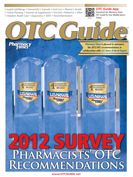Publication
Article
OTC Guide
Promoting the Proper Use of Emergency Contraception
OTC emergency contraceptive (EC) use is both an ethically and therapeutically charged issue. Ethically, controversy arises over product mechanism of action (MOA) and, therapeutically, around unintended use as routine contraception. In order to help facilitate understanding, pharmacists can review the trials evaluating drug MOA, along with the risks, contraindications, counseling points, and public health implications of emergency contraception.
History and Proposed MOA
Hormonal post-coital contraception was first introduced in the late 1970s by Yuzpe and Lance, who suggested use of 0.1 mg ethinyl estradiol/0.5 mg levonorgestrel within 72 hours of intercourse followed by repeat dosing 12 hours later.1 This was standard post-coital contraception until introduction of the levonorgestrel only method.1 Currently, 1.5 mg levonorgestrel once, or two 0.75 mg levonorgestrel doses separated by 12 hours, have emerged as gold standards— with the former preferred over the latter.
Current research is working to best clarify levonorgestrel’s MOA. A 2006 study published in Contraception by Novikova et al looked at EC effectiveness when administered before versus after ovulation in patients who came to family planning clinics with EC requests.2 Blood samples were drawn prior to EC administration in order to definitively ascertain time to ovulation.
Of the 51 participants who were deemed to have had intercourse within 5 days prior to or during ovulation (according to endocrine data), only 3 were found to be pregnant upon follow-up. All 3 pregnancies resulted in cases where intercourse occurred on the day of, or 1 day before, ovulation and EC administration was initiated 2 days after ovulation. Study authors concluded their data confirmed prior studies suggesting that levonorgestrel has no effect on the status of a pregnancy after ovulation and, hence, “does not interfere with postfertilization events.” Larger studies are needed to confirm these findings.
Studies suggest that levonorgestrel works by either delaying follicular development or arresting unruptured follicles. Levonorgestrel has also been observed to have a very narrow effect window: after dominant follicle selection and before the luteinizing hormone surge.1,2 Administration outside this window fails to prevent ovulation as it will have already begun, making pregnancy more likely.
Contraindications and Adverse Effects
Because EC agents are sold over the counter, and refusal to dispense due to personal beliefs is not an option in many states, pharmacists have a heightened responsibility when it comes to screening for contraindications and providing sufficient counseling and risk disclosure.
Progestin-only ECs have 2 main contraindications: known or suspected pregnancy and known patient allergy to product ingredients.3 Levonorgestrel EC is contraindicated in pregnancy not because of fetal risk, as it has not been shown to be harmful to the fetus, but known inefficacy.3-5 Levonorgestrel EC use during early pregnancy, though limited data are available, has not been shown to cause fetal harm but is known to be ineffective at terminating pregnancies; it has no contraceptive or abortive role during active pregnancy.1-3
It is important to counsel patients that known pregnancy cannot be terminated with levonorgestrel EC.3 Most risks associated with levonorgestrel are mild to moderate and include irregular bleeding, spotting, nausea, vomiting, abdominal pain, and fatigue.3 Because ectopic pregnancy has been identified as a rare side effect, patients should be counseled to seek emergency medical attention if they experience severe abdominal pain.3
Counseling Points
Optimizing Use, Minimizing Side Effects
In order to optimize EC use, counsel patients to begin EC administration within 72 hours of unprotected intercourse.3 A single-dose product is preferred over a 2-step product in women concerned about compliance.5 However, women choosing a 1-step product may experience increased side effects.6 If vomiting occurs within 2 hours of administration, counsel patient to seek medical advice, as the dose may need to be repeated.3 Side effects may be reduced by recommending the 2- tablet regimen.6
When Is Efficacy Decreased?
Patients should be educated that levonorgestrel cannot guarantee protection from pregnancy and should not be used as one’s primary method of contraception but rather as “backup” in cases of primary method failure.3 If the patient finds that her menstrual period is delayed a week longer than expected, pregnancy test administration is advised.3 Although EC efficacy is a function of when the sexual encounter occurred and the timing of administration, other factors, such as enzyme inducers, may contribute to decreased levonorgestrel efficacy.
The pharmacist should check patient profiles for cytochrome P450 3A4 inducers and inquire as to herbal supplements the patient may be taking. Levonorgestrel may also cause significant changes, both increases and decreases, in HIV protease inhibitor and nonnucleoside reverse transcriptase inhibitor concentrations3 —advise the patient taking these medications to consult with her physician. Remind patients that EC use does not protect against HIV/AIDS and other sexually transmitted infections.3
Thoughts on Public Health
Finally, the effect of EC availability and use on public health cannot be overlooked. Proponents argue that EC benefits are derived from a reduction in unintended pregnancies, number of abortions, and health care costs.4 Additionally, studies in Finland and Switzerland, which have had longer EC exposure than the United States, have found no pattern of repeated EC use among adolescents with easy access to the products.7
However, these results conflict with a study conducted in China; authors found no decrease in unwanted pregnancies with advanced EC provision.8 Authors concluded that a reduction in abortion rates is similarly unlikely.8 Conflicting results may reflect the possibility that EC contribution to public health risk/ benefit may vary by culture.
Conclusion
As much uncertainty surrounds OTC use of EC, especially when it comes to MOA and public health concerns, it is clear that the role of the pharmacist should not be underestimated. Most importantly, patients need full disclosure: let them know exactly what it is they are choosing to purchase. Screen their profile, assure safety. Counsel them on proper medication use and how to prevent another contraceptive emergency. Dispense the drug. As is the case with all OTC medications, the well-informed, autonomous patient will be equipped to make the best possible personal decisions.
Ms. Eldasher is a PharmD candidate at the Ernest Mario School of Pharmacy at Rutgers University, and Dr. Prescott is vice president of Clinical and Scientific Affairs for Pharmacy Times.
References
1. Gemzell-Danielsson K. Mechanism of action of emergency contraception. Contraception. Nov 2010;82(5):404-409.
2. Novikova N, Weisberg E, Stanczyk FZ, Croxatto HB, Fraser IS. Effectiveness of levonorgestrel emergency contraception given before or after ovulation--a pilot study. Contraception. Feb 2007;75(2):112-118.
3. Plan B One-Step (levonorgestrel) Prescribing Information. 2009.
4. Camp SL, Wilkerson DS, Raine TR. The benefits and risks of over-the-counter availability of levonorgestrel emergency contraception. Contraception. Nov 2003;68(5):309-317.
5. Dominguez L, Downing DF, Jordan B, Kurnik D, Schwarz EB, Trussell J, Westley E. Emergency contraception: Update for pharmacists. Pharmacy Today. Jun 2010; 50(6):48—60.
6. Arowojolu AO, Okewole IA, Adekunle AO. Comparative evaluation of the effectiveness and safety of two regimens of levonorgestrel for emergency contraception in Nigerians. Contraception. Oct 2002;66(4):269-273.
7. Belzer M, Sanchez K, Olson J, Jacobs AM, Tucker D. Advance supply of emergency contraception: a randomized trial in adolescent mothers. J Pediatr Adolesc Gynecol. Oct 2005;18(5):347-354.
8. Hu X, Cheng L, Hua X, Glasier A. Advanced provision of emergency contraception to postnatal women in China makes no difference in abortion rates: a randomized controlled trial. Contraception. Aug 2005;72(2):111-116.

Newsletter
Stay informed on drug updates, treatment guidelines, and pharmacy practice trends—subscribe to Pharmacy Times for weekly clinical insights.






